Whether you’re a seasoned professional or just starting, having the right woodworking tools is essential for bringing your woodworking projects to life. In this comprehensive guide, we’ll explore the essential woodworking tools every woodworker needs to have in their arsenal, from the basic hand, carpentry, and measuring tools to specialized power tools that can elevate your craft to new heights.
Must-Have Hand and Carpentry Woodworking Tools
1. Workbench

The workbench is the heart of any woodworking workshop, providing a sturdy and versatile surface for various tasks. Its primary function is to support wood pieces during cutting, assembly, sanding, and finishing.
A spacious work surface provides ample room for maneuvering and working on large projects, while sturdy construction ensures stability and support for heavy workpieces. Additionally, features such as built-in storage, adjustable height, and clamping options enhance versatility and functionality. It comes in various styles and materials, including traditional wooden benches, metal-framed benches, and portable workbenches. Each type offers unique advantages depending on the workshop’s needs and space constraints.
2. Chisel
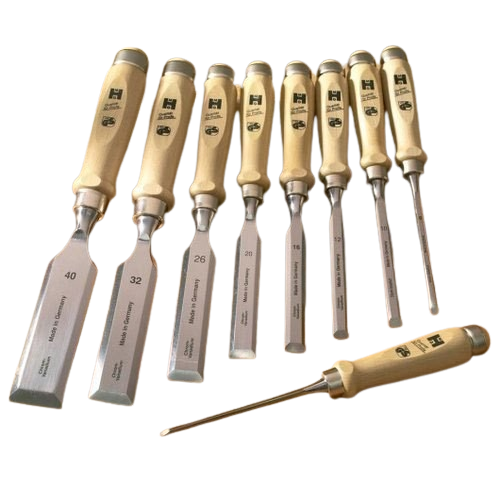
Chisels are essential woodworking tools, each with a unique shape and size tailored to specific tasks. Bench chisels, featuring beveled edges, are versatile and can fit into tight spaces, ranging from narrow widths of 1/4″ to broader ones of up to two inches. Heavy-duty mortise chisels boast thick blades with square edges, designed to withstand the force of chopping mortises. Paring chisels, with thin and flexible blades, sharpened to a steep angle, excel at delicate end grain work.
When choosing chisels, opt for high-quality materials like high-alloy carbon steel or chromium-vanadium alloyed steel for durability. Ensure ergonomic grips, preferably hardwood with metal caps, to withstand hammering. From intricate mortise work to chipping out, a well-rounded set of chisels is indispensable for any woodworking project, offering precision and versatility in shaping wood with finesse.
3. Tape Measure
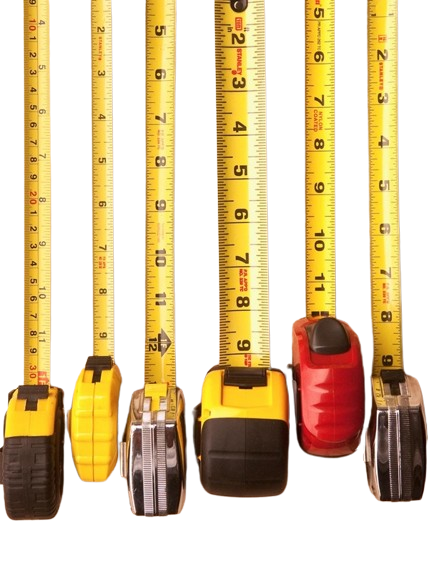
The tape measure is a cornerstone tool in woodworking, serving as the go-to instrument for precise measurements and layout. Its flexible, retractable blade allows woodworkers to measure distances accurately, whether for marking cuts, determining dimensions, or ensuring alignment. Tape measures come in various lengths, typically ranging from a few feet to several meters, It’s advisable to invest in a retractable one that extends to at least 25 feet in length to accommodate diverse project requirements.
Precision is paramount in woodworking, especially in large-scale projects. Therefore, ensuring that the “hook” or tab at the end of the tape measure is securely attached, with no give, is crucial. Even the slightest variation in this attachment can lead to discrepancies of up to 1/8 inch in measurements over time, potentially causing significant accuracy issues.
4. Hammer
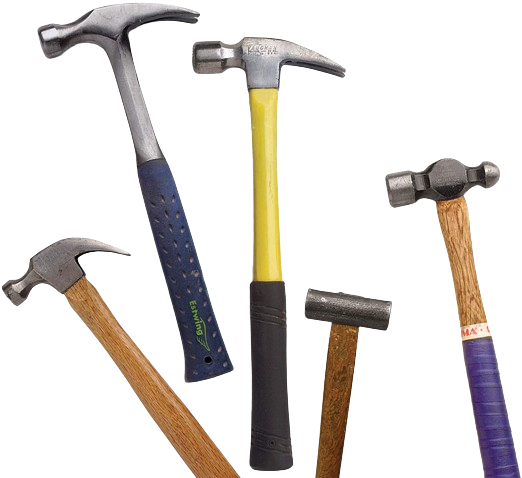
With its sturdy construction and ergonomic design, the hammer provides woodworkers with the leverage and force necessary to tackle various projects with confidence. There are several types of hammers commonly used in woodworking, each designed for specific purposes. The claw hammer, with its dual-functioning head featuring a flat striking surface and a curved claw for nail removal, is the most versatile and widely used in woodworking. For more specialized tasks, such as delicate finish work or driving small nails, a smaller and lighter hammer, such as a tack hammer or a trim hammer, may be preferred.
5. Screwdriver
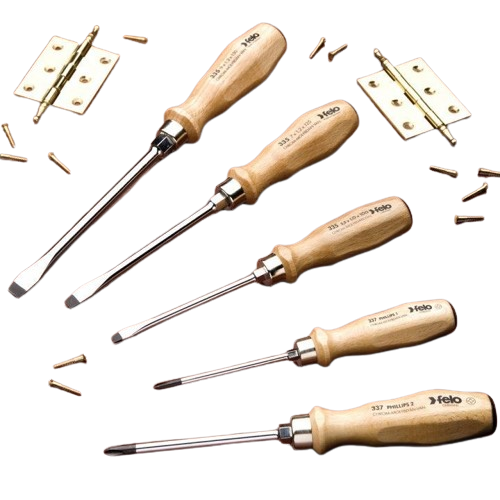
Whether you’re building furniture, installing hardware, or constructing wooden structures, the screwdriver remains an essential woodworking tool in your toolkit. Its primary function is to tighten or loosen screws, allowing woodworkers to secure joints and fasten components securely.
Screwdrivers come in various types, including flathead, Phillips, and Robertson (square), each designed to match specific screw types. Additionally, screwdrivers may feature magnetic tips to hold screws in place, making it easier to work in tight spaces.
6. Utility Knife
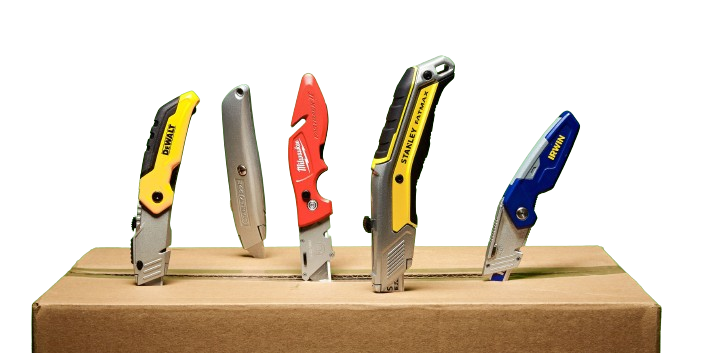
One of the primary functions of the utility knife in woodworking is to score or cut materials before further processing. Whether it’s trimming veneer, scoring laminate, or cutting masking tape, the utility knife’s sharp blade ensures precise cuts with minimal effort.
When selecting a utility knife, it’s essential to consider factors such as blade quality, blade locking mechanism, and handle comfort. High-quality blades made of durable materials like carbon steel or stainless steel ensure longevity and maintain sharpness over time. A reliable blade-locking mechanism provides safety and stability during use, preventing accidental blade slippage or retraction.
7. Sliding Bevel
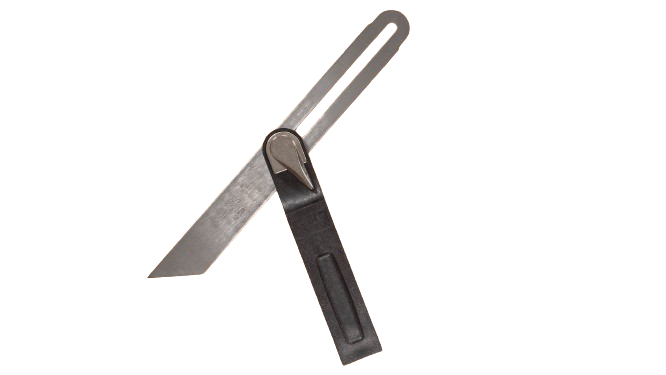
The sliding bevel, also known as a bevel gauge or angle gauge, is a versatile and essential woodworking tool, prized for its ability to measure and transfer angles accurately. Its simple yet ingenious design consists of a handle and a blade that can be adjusted and locked at various angles, allowing woodworkers to replicate and transfer angles with precision.
8. Squares

The square is a fundamental tool in woodworking, essential for ensuring precise right angles and straight edges. Its simple yet versatile design consists of a straight edge (blade) and a perpendicular handle (stock), allowing woodworkers to check and mark 90-degree angles accurately.
Squares come in various sizes and styles, including combination squares, try squares, and speed squares, each offering unique advantages depending on the woodworking task at hand. Combination squares, for example, feature adjustable blades that can be set at different angles, while try squares have fixed 90-degree angles for quick and straightforward measurements.
9. Nail Setter
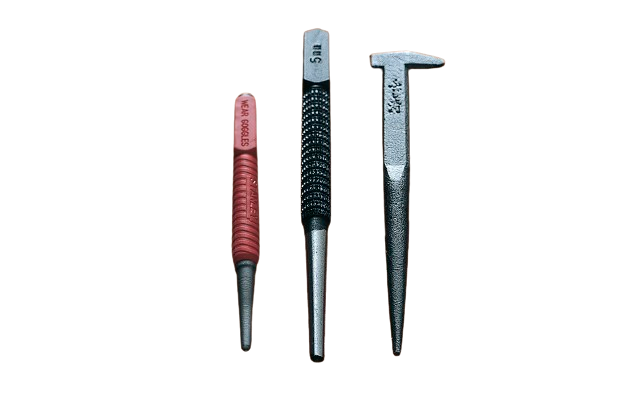
With its pointed tip and concave head, the Nail Setter allows for precise nail placement and countersinking without damaging the wood. Ideal for finishing tasks like installing trim or paneling, the nail setter ensures a professional-quality result with ease and accuracy.
10. Hand Plane
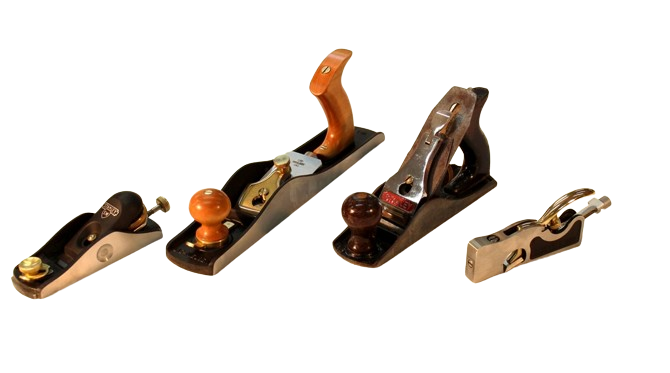
Whether you’re flattening a tabletop, smoothing a door, or chamfering an edge, the hand plane remains an indispensable woodworking tool. Hand planes come in various sizes and styles, including bench planes, block planes, and specialty planes, each offering unique advantages depending on the woodworking task at hand. Bench planes, for example, are ideal for flattening and smoothing large surfaces, while block planes are compact and portable, making them suitable for smaller projects or on-the-go use.
High-quality blades made of durable materials like high-carbon steel ensure sharpness and longevity, while sturdy bodies made of materials like cast iron provide stability and control during use enabling woodworkers to achieve smooth and even surfaces with minimal effort.
11. Clamps
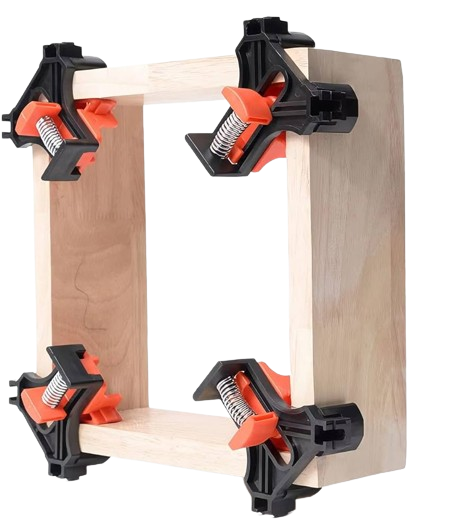
Woodworking clamps are indispensable tools for holding workpieces, They work by exerting pressure on workpieces, securely holding them in place while glue dries, joints are assembled, or cuts are made. These clamps come in various types, including bar clamps, spring clamps, and C-clamps, each suitable for different applications.
When selecting woodworking clamps, it’s essential to consider factors such as clamping capacity, throat depth, and clamping force. High-quality woodworking clamps of durable materials provide reliability and longevity, while ergonomic designs enhance their usability.
12. Sawhorse
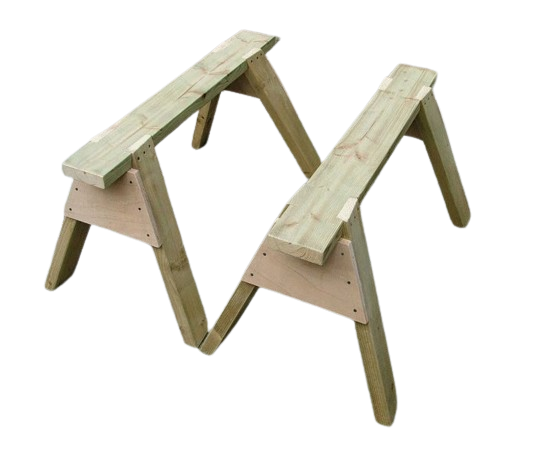
Sawhorses consist of four legs and a horizontal beam, typically made of wood or metal, forming a triangular shape that distributes weight evenly and prevents tipping. The primary function of sawhorses is to elevate workpieces off the ground, allowing for comfortable and safe cutting with hand saws, circular saws, or other power tools.
They provide a stable base for supporting long or heavy materials, such as lumber or plywood, during cutting or assembly, reducing the risk of injury and ensuring accurate cuts.
13. Wood Moisture Meter
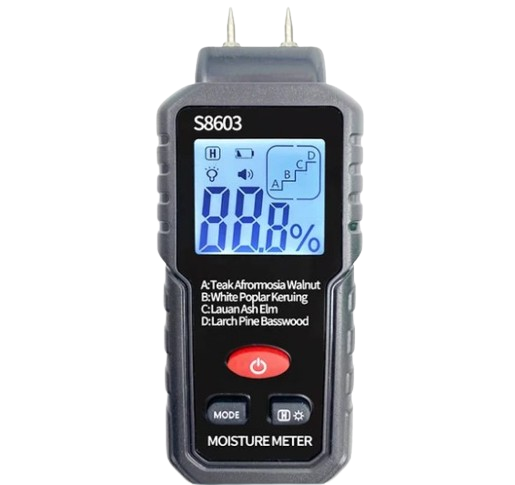
The moisture content of wood is essential to monitor because it affects its stability, strength, and suitability for various applications. Wood that is too wet can warp, crack, or decay, while wood that is too dry may become brittle and difficult to work with.
Using a moisture meter, woodworkers can accurately determine the moisture content of wood before beginning a project, allowing them to select appropriately seasoned materials or take corrective actions such as drying or conditioning the wood as needed. Moisture meters come in various types, including pin-type meters, pinless meters, and combination meters that accurately measure the moisture content of wood materials.
14. Pair of Dividers
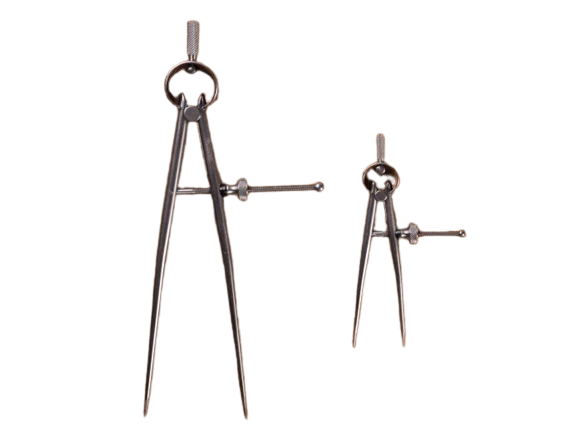
The primary function of dividers as woodworking tools is to scribe circles, arcs, or lines on wood surfaces, facilitating layout and marking tasks during woodworking projects. Woodworkers can use dividers to transfer measurements, divide distances into equal parts, or mark out specific dimensions for cutting, drilling, or shaping.
The pair of dividers come in various sizes, with some featuring sharp points for scribing and others equipped with pencil or marking attachments for more versatile marking options.
15. Marking Gauge
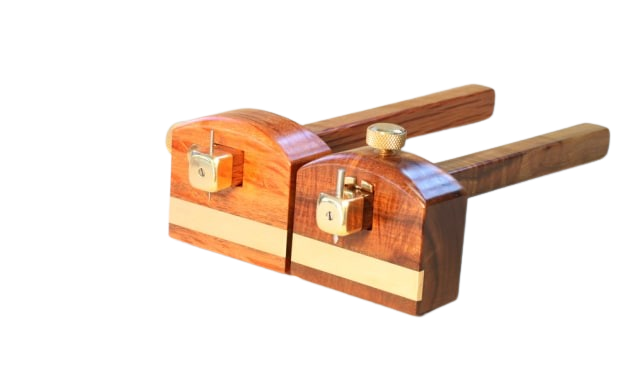
The marking gauge typically consists of a fence or beam that runs along the edge of the wood, with a marking blade or pin that can be adjusted to set the desired distance from the edge. The primary function of a marking gauge is to scribe lines on the surface of the wood, indicating the location for cuts, joinery, or other woodworking operations.
Moreover, marking gauges come in various styles, including wheel gauges, pin gauges, and cutting gauges, each offering unique advantages depending on the specific woodworking task at hand. Wheel gauges use a small cutting wheel to scribe lines on the wood surface, while pin gauges use a sharp pin or spur to mark the wood. Cutting gauges feature a small blade or knife that cuts into the wood to create a deeper and more precise line.
Essential Power Woodworking Tools
16. Power Drill
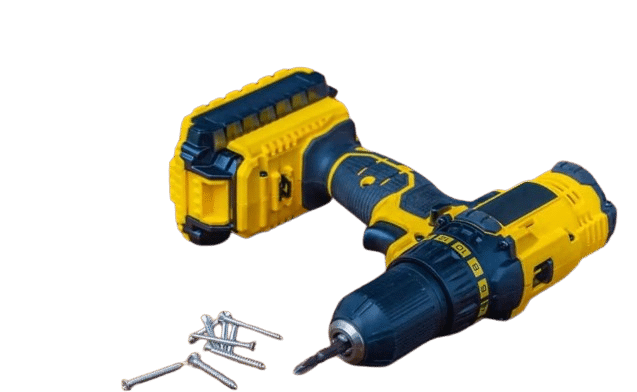
One of the primary functions of a power drill is drilling holes in wood, metal, plastic, and other materials. With its adjustable speed settings and various drill bit attachments, the power drill can bore holes of different sizes and depths, making it indispensable for a wide range of woodworking applications.
Power drills come in various types, including corded drills, cordless drills, and hammer drills, each offering unique advantages depending on the specific task at hand. In addition to drilling, power drills can also be used for driving screws and fasteners into wood or other materials. Many woodworking power drills feature a reversible function that allows for both forward and reverse drilling, making it easy to insert or remove screws quickly and efficiently.
17. Jigsaw

A jigsaw is a woodworking tool used for cutting curves and irregular shapes in wood, plastic, metal, and other materials. Its narrow blade moves up and down rapidly, allowing for smooth and accurate cuts along curved lines. Jigsaws come in various types, including corded and cordless models and models with different power ratings and blade sizes. Cordless jigsaws offer greater portability and convenience for on-the-go projects, while corded models provide continuous power for longer periods of use.
While choosing a jigsaw, it is important to consider factors such as power, speed, blade type, and ergonomic design. High-quality jigsaws with variable speed settings, orbital action for faster cutting, and comfortable grips ensure efficient and precise cutting in any woodworking project.
18. Surface Planer
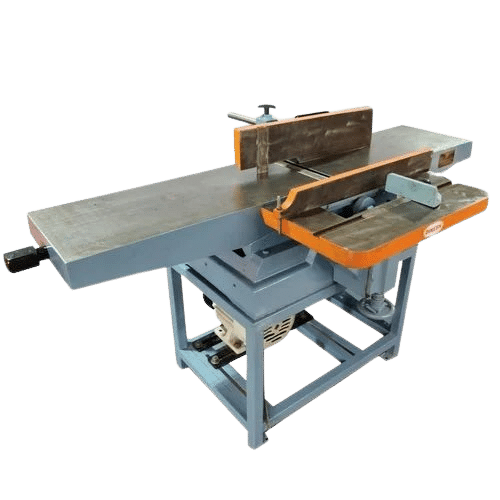
Enter the surface planer, the woodworking maestro that turns raw lumber into polished perfection. With its spinning cutter head and adjustable bed, this tool is the craftsman’s best friend for achieving flat, uniform boards with ease. At the heart of its function lies the ability to level rough wood, effortlessly smoothing out imperfections and irregularities. By feeding lumber through its blades, the surface planer transforms jagged edges into sleek surfaces, ready for the next stage of craftsmanship.
From fine woodworking to heavy-duty projects, this versatile tool adapts to the demands of any workshop and comes in various sizes and configurations, from benchtop models suitable for small workshops to industrial-sized machines capable of handling large-scale production.
19. Router
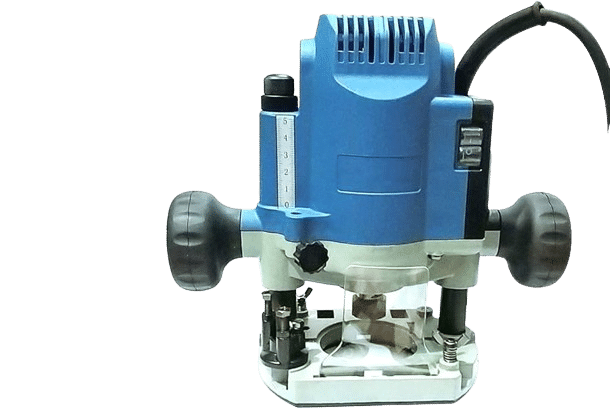
With its spinning bit and customizable depth, the router is a craftsman’s best friend for sculpting wood into works of art. Its primary function is to shape wood by removing material with its rotating bit. At its core, the router is a master of versatility, capable of shaping, edging, and joining wood with unparalleled precision. Whether it’s crafting intricate patterns, adding decorative edges, or creating seamless joints, the router empowers woodworkers to unleash their creativity.
Routers come in various types, including handheld routers and router tables, each offering unique advantages depending on the woodworking task at hand. Handheld woodworking routers provide portability and flexibility for freehand routing, while router tables offer stability and accuracy for more controlled operations.
20. Miter Saw
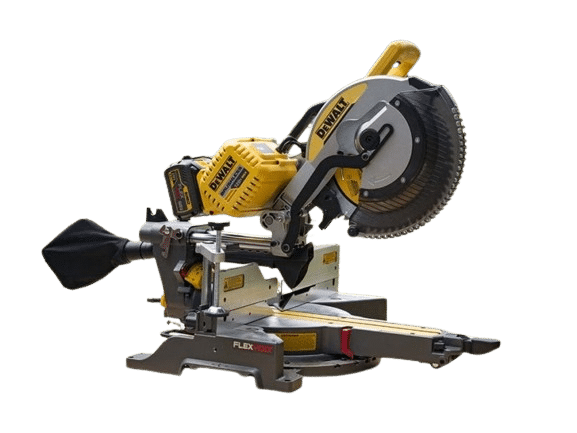
With its sleek design and razor-sharp blade, this tool is the craftsman’s trusted companion for achieving flawless cuts with precision and finesse. What sets the miter saw apart is its versatility. From crafting intricate frames to installing crown moldings, this powerhouse tool handles a myriad of cutting tasks with ease. Its ability to create precise miter and bevel cuts unlocks a world of creative possibilities, allowing woodworkers to bring their visions to life with accuracy and confidence.
21. Band Saw
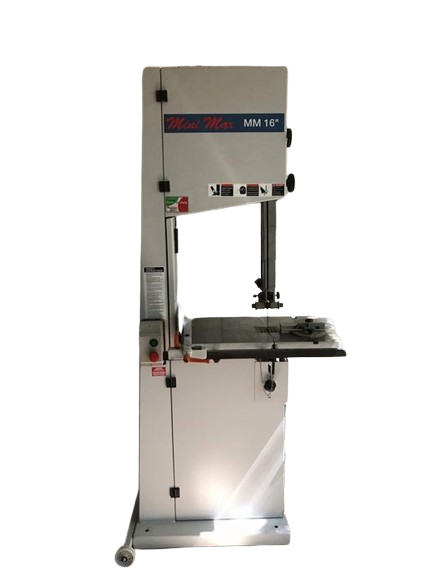
The band saw stands as a stalwart companion in woodworking shops, offering unmatched versatility and precision. With its continuous loop blade stretched over two wheels, this mighty tool is capable of cutting curves, resawing thick stock, and even making intricate designs with ease.
At the core of its functionality lies the ability to make precise cuts through various materials, including wood, metal, and plastic. The band saw’s slender blade allows for intricate cuts, while its adjustable table and fence provide stability and accuracy, making it ideal for both intricate detailing and bulk material removal.
22. Table Saw
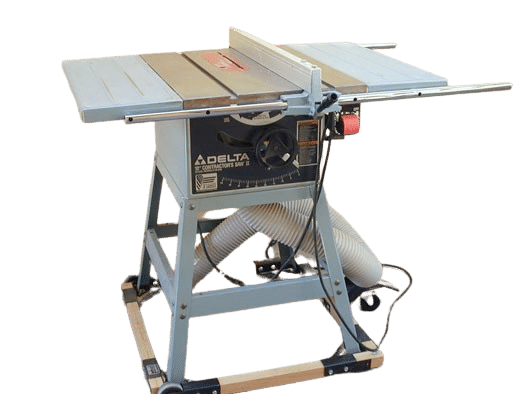
Featuring a flat table surface with a circular blade protruding from the center, the Table Saw is capable of making straight cuts, bevel cuts, and even dado cuts with ease. One of the primary advantages of this essential woodworking tool is its ability to make repeatable cuts with consistency. Whether it’s cutting multiple pieces to the same dimensions or creating intricate joinery, this versatile tool ensures uniformity and precision, saving time and effort in the workshop.
In addition to its cutting prowess, the table saw is also known for its safety features, including blade guards, riving knives, and anti-kickback mechanisms. These features help minimize the risk of accidents and ensure a safe working environment for woodworkers of all skill levels.
23. Circular Saw
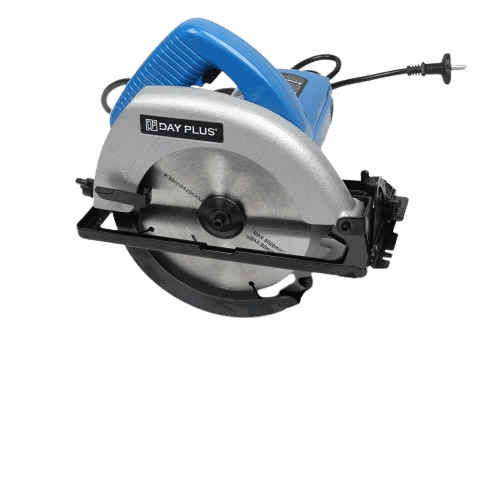
The circular saw stands as a pillar of versatility in woodworking and construction, prized for its portability and ability to make quick and accurate cuts. Featuring a circular blade that spins rapidly, this handheld woodworking tool is capable of cutting through a variety of materials with ease, including wood, metal, and plastic.
Furthermore, the circular saw’s affordability and ease of use make it a popular choice among DIY enthusiasts and professionals alike. Whether you’re building a deck, framing a house, or crafting custom furniture, the circular saw is a reliable and indispensable tool that gets the job done quickly and efficiently.
24. Biscuit Joiner
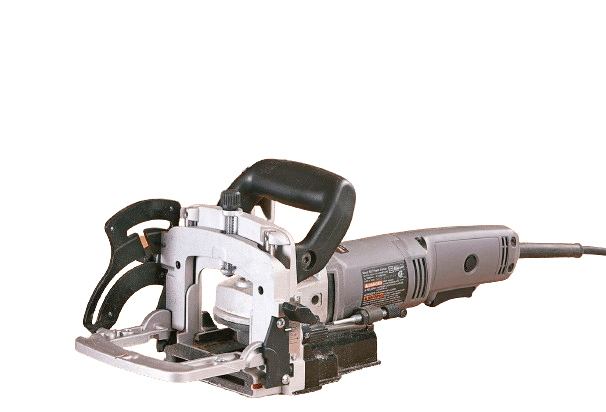
Biscuit Joiner is a woodworking wizard that revolutionizes the way wood pieces are joined together. Unlike traditional methods that rely on complex joinery techniques, the biscuit joiner simplifies the process with its innovative design and ease of use.
With adjustable settings for depth and angle, woodworkers have the freedom to customize their joints to suit their specific project needs. Whether it’s aligning panels, assembling cabinets, or constructing furniture, the biscuit joiner offers unparalleled flexibility and precision. From hobbyists to seasoned professionals, the biscuit joiner is a game-changer in the woodworking world.
25. Impact Driver
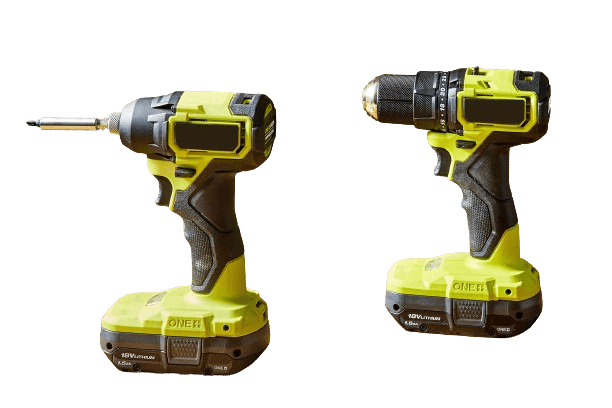
The impact driver, a true workhorse, is renowned for its power, speed, and efficiency. With its compact design and high-torque output, this versatile woodworking tool is a staple on job sites and in workshops, capable of driving screws and fasteners with unmatched force and precision.
Its hammering action, which delivers rotational force in rapid bursts, allows the impact driver to tackle even the toughest fastening tasks with ease. Whether it’s sinking screws into hardwoods, driving lag bolts into framing, or assembling furniture, the impact driver powers through with unrivaled speed & effectiveness.
In conclusion, when it comes to woodworking, having the right tools is essential for success. From measuring and cutting to joining and finishing, each tool plays a crucial role. By investing in high-quality woodworking tools and understanding their uses, you can enhance your craftsmanship and create beautiful pieces with precision and ease.
Remember, woodworking is a versatile craft that encompasses various techniques and projects. Whether you’re a beginner or an experienced woodworker, having a well-rounded collection of tools will enable you to tackle a wide range of woodworking tasks with confidence.
So, explore different types of woodworking and discover the tools that best suit your needs and preferences. With the above-mentioned woodworking tools, the possibilities are endless, allowing you to unleash your creativity to create truly remarkable wooden pieces that stand the test of time.

